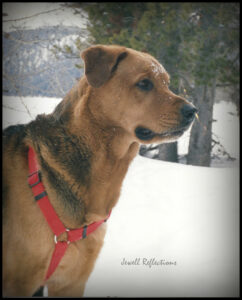By Fran Jewell

Today, DNA testing for breed is a commonplace and easy thing to do. There are many companies that offer testing at very reasonable prices that are more and more correct. I have even DNA tested my purebred dog for breeding purposes to ensure identity.
But, why would I DNA test a mutt or mixed-breed dog? Since the beginning of the domestication of the wolf to a dog, we humans have sought to breed for certain characteristics from the wolf to help us improve our everyday lives. We started breeding wolf/dogs with a higher sense of scenting ability to help us hunt and retrieve food — the hunting breeds such as the Labrador retriever, wirehaired pointer, golden retriever, and so on. We took the wolves with the most guarding instinct and bred them to help guard our livestock — the Great Pyrenees, Anatolian, and Akbash. We looked for the wolves with the most protective instincts to protect us, such as the black Russian, the Fila, and many of the mastiffs. When we decided we needed dogs to help us herd our livestock, we bred and created cattle dogs, Australian shepherds, border collies, and German shepherds. As you can see, there are many different breeds within a working group.
When we don’t know what that cute little rescue has instincts for, we may mistake some natural behaviors as bad behaviors, or even as aggression. A border collie that chases and barks at cars or people on bikes may actually be manifesting his gathering-and-chasing herding instinct. This can be misinterpreted as aggression, or maybe instinct at first that then turns into aggression.
Now, let’s take this further. Suppose we have a cattle-dog-and-Labrador-mix. The Labrador’s instinct is going to be to flush the birds for the hunter, then find the bird and retrieve it. Now, the cattle-dog part is bred to bite, and bite HARD, on the heels of cattle to get them to move in the desired direction. Now we have what is called conflicting drives or instincts. A dog that looks mostly Labrador but has more internal drive to chase and bite or nip is not going to be very gentle on the bird you were hunting. Let’s throw into the mix a rat terrier whose instinct is to go to the ground and kill vermin. What is this mix going to do in the field —hunt birds or chase and kill vermin? And what if this dog is never in the field with a hunter? What will he chase and kill? Will he have a soft mouth? Will he be good with small children that run and scream like prey?
There is nothing wrong with mixed-breed dogs, but understanding what their natural drives and instincts are will help you to decide if this dog will fit in your family. Size, coat length and friendliness are not the only things important when choosing a dog to live with for 14 years! Instinctual drives can be very difficult to control or redirect. It can be done; however, lots of training and understanding must also be a part of the consideration.
My first search-and-rescue dog, Tazzi was half-Rottweiler, one-quarter Husky and one-quarter German shepherd. She loved to run with boundless energy, and loved to use her nose to search. While she had mixed drives — from herding, to pulling, to guarding — her drives just happened to blend very well. However, she was not without tons and tons of work to direct her drives.
Just like buying a car, most people don’t just buy a car for looks. They want to know what is under the hood!
Fran Jewell is an IAABC Certified Dog Behavior Consultant, NADOI Certified Instructor and the owner of Positive Puppy Dog Training, LLC in Sun Valley. For more information, visit positivepuppy.com or call 208-578-1565.


